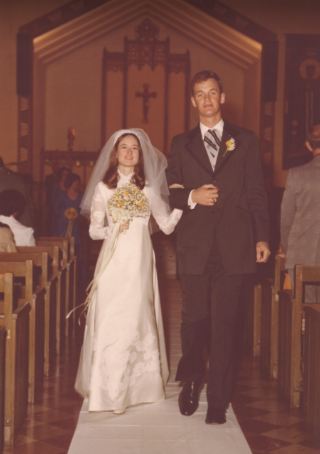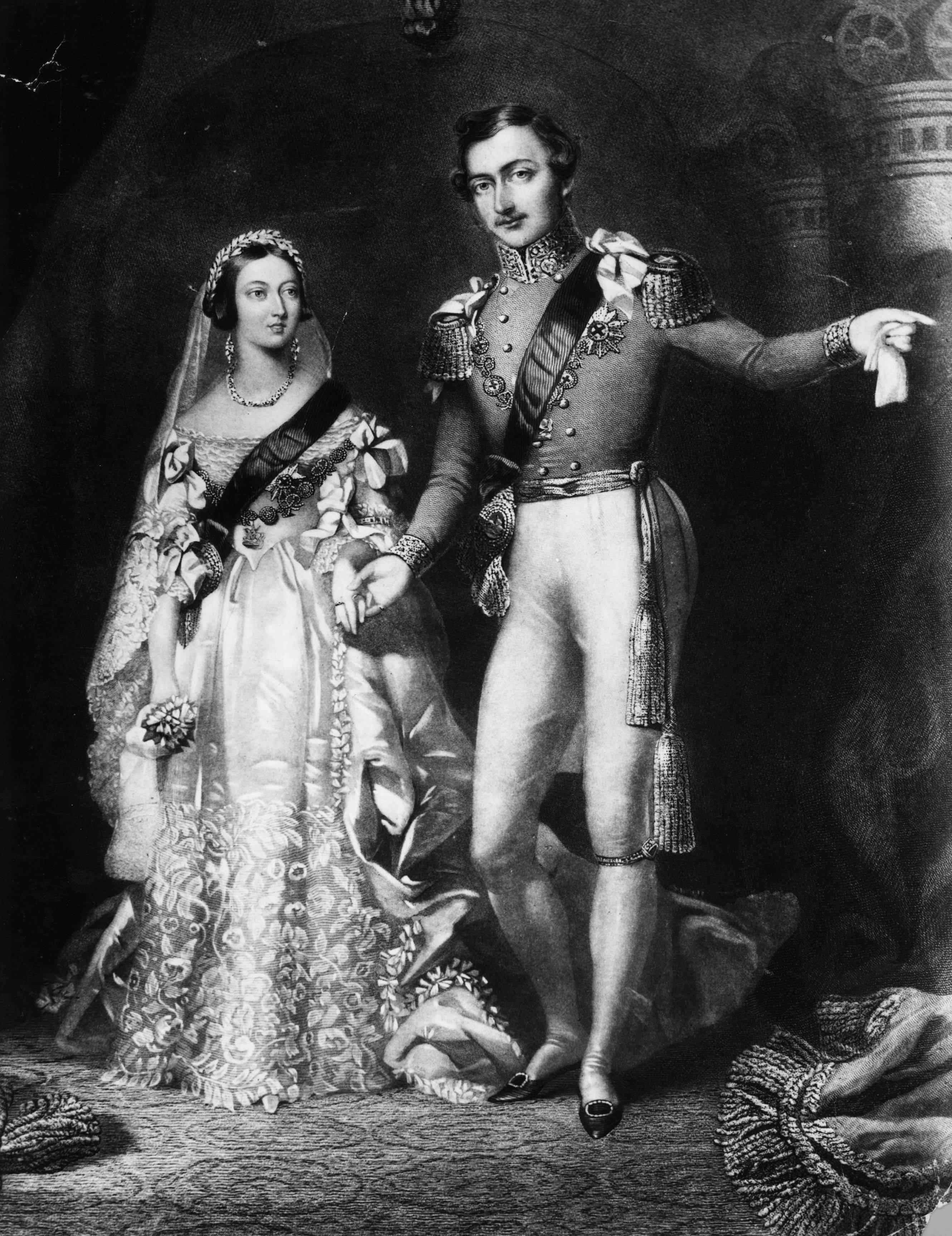
My wedding anniversary is tomorrow, November 26, so for this month’s post on life during the 1840s, my topic is weddings of the times.
In the early years of our nation, weddings were low-key affairs, typically held in the bride’s home and attended only by family and close friends. Weddings were typically on a week-day morning, followed by a wedding breakfast. An announcement was made at the couple’s church—if they had a church—on the Sunday following the wedding.The bride did not often purchase a new dress, but wore her best.
By the 1840s, wealthier Americans in the East had started having more lavish wedding celebrations. Although brides did not always wear white wedding gowns, white was a popular choice, even before Queen Victoria’s wedding to Prince Albert in 1840. Queen Victoria chose a white satin dress with a lace overskirt. She selected these fabrics to support impoverished neighborhoods in London, and over the next decade or two, the custom of the bride wearing a white wedding spread across England and America.

Over time, the practice of wearing a dress made specifically for the wedding also moved into the American middle classes. However, traditions such as these simply were not possible on the frontier. Along the Oregon Trail and in the West, it was sometimes difficult to purchase even necessities, let alone luxuries. Families didn’t have a lot of extra clothes, nor cash to spend.
Most women on the frontier simply wore their best dress for their wedding, not even necessarily acquiring a new dress. Often, these best dresses were dark colors and simply styled. White was simply not a practical color to wear in a land of grit and wind.
In the early 1800s, wealthier Americans also started having more elaborate wedding feasts. The wedding ceremony itself might still be a small affair, but it was followed by a grander feast. Over time, the ceremonies moved from the bride’s home to churches, primarily to accommodate more guests. When the weddings became large social events, the attendees could not fit into the bride’s home.
Poorer families, if they had a celebration beyond family, would have had a “pot luck” event to which their friends contributed. They could not afford to feed the entire neighborhood.
Most frontier weddings remained frugal affairs, such as in the early years of our nation. Moreover, there were few ministers and even fewer churches available, so couples sometimes began “common law” marriages, which were celebrated when a minister was found.
In Lead Me Home, I described many of the frontier wedding practices, though with some variations. The couple waited to find a minister along the trail, which happened sooner than they had anticipated.
The bride (I won’t tell you which character was the bride—you’ll have to read the book!) wore a new blue calico dress. The dress was made for her wedding, but it would have been a practical choice for her life in the West.
The bride wore “something old, something new, something borrowed, something blue” for good luck. I could verify that this tradition existed during Victorian times, but I have not been able to establish that it was common on the American frontier. Nevertheless, it gave me a couple of pages of nice dialogue.
The wagon company held a potluck wedding feast to celebrate the marriage. They were celebrating their stopover at Independence Rock also. And they held a “shivaree” for the newly married couple—an American tradition of the times.
What weddings have you attended that broke with tradition in some way?




My parents were married in my mother’s home with a handful of guests who enjoyed cake and punch in the dining room after the ceremony. This was in 1949, and I thought it was just because they were such sensible people from not-wealthy families who wouldn’t dream of dropping several thousands of dollars on a wedding. I didn’t realize that sort of wedding was a vestige of the tradition of an earlier time. Some years later my husband and I were married in a chapel on the university campus followed by a small reception at the apartment of friends.
It still seems sensible to me put the resources to the marriage that follows rather than the wedding, but in the era of destination weddings and such I know I’m way out of synch with the times. And I know there’s something to be said for bringing all family and friends together to witness and celebrate. Fortunately for our bank account neither of my offspring has indicated any interest in marrying anyone, let alone with a blow-out bash. Yet.
Thanks for the post. And reminder of a part of your book. The sequel of which I eagerly anticipate…..
Linda,
I agree with you on sensible weddings. Destination weddings are lovely, but often impractical.
Thanks for the comment. And I’m hard at work on the sequel to Lead Me Home!
Theresa
My son, Paul, is a quadriplegic because of too deep a dive in a lake. He uses a wheelchair. He and his bride Olive were married at North Beach which is part of Deception Pass State Park in Washington. They were married on the beach with the most beautiful scenery in the world in the background on a gorgeous sunny day in July. However in order to get Paul to the beach his brothers had to wheel him down a fairly steep trail down a bank and across a small bridge. Then his brother had laid a path of 4×8 sheets of plywood over the sand so the groom could be at the shore when his bride joined him. Olive’s parents are deceased so I was the mother of both the bride and the groom. It was a great day and a great ceremony but I worried myself sick for the week before because it rained every day. One of my friends said “God loves those two”.
What a lovely story, Virginia. Deception Pass is a beautiful setting. It sounds as if their wedding was blessed.
Theresa
I went to a wedding for four couples at the same time. It was very weird when the preacher announced the couples by number.
Will Couple Number 4 please come forward? That is unusual. I’ve heard of double weddings, but not four.
Happy Anniversary, Theresa! Thinking back, most weddings I’ve attended were traditional. I did have a friend who eloped in Las Vegas, but these days, that could be considered traditional. I hope you had a wonderful Thanksgiving.
I officiated at a wedding in an area park–in the rain. The guests stood under umbrellas and the bride was an hour late! By the time the short service was over, everyone was soaked!
Sounds like this weekend in Kansas City!